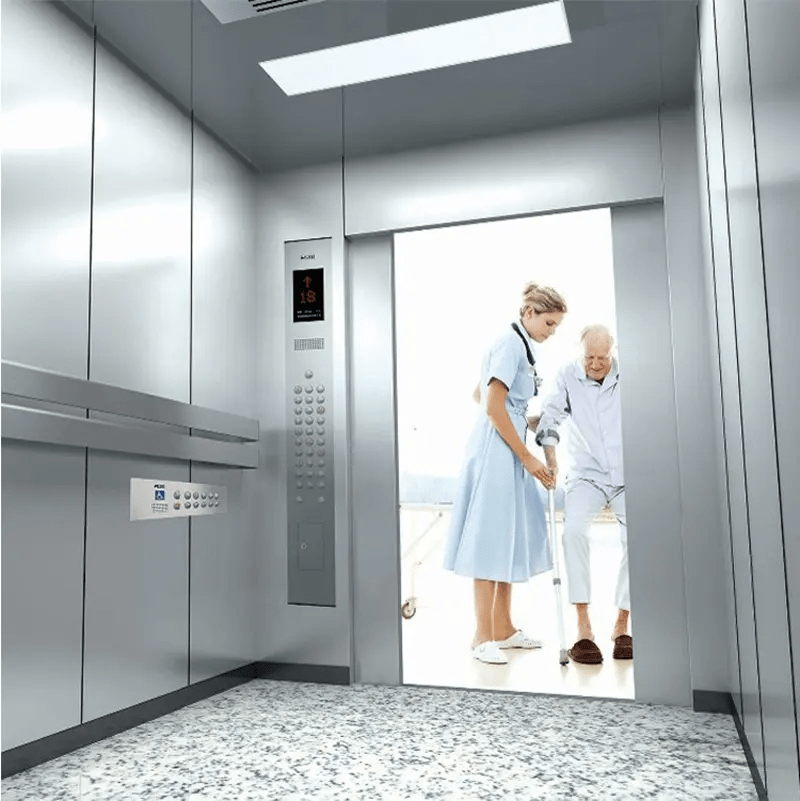Lift Elevator for Hospital
Hospitals require reliable and efficient lift elevators to ensure the smooth movement of patients, medical staff, and equipment. These elevators are designed to accommodate stretchers and wheelchairs, providing quick access to different floors. With advanced safety features and hygiene-focused designs, hospital elevators enhance accessibility and improve healthcare efficiency.
Product Description
Lift Elevator for Hospital
Hospitals require efficient, safe, and reliable vertical transportation to move patients, medical staff, and equipment. A well-designed hospital elevator ensures smooth and quick access to different floors, improving operational efficiency. These elevators accommodate stretchers, wheelchairs, and medical personnel, providing seamless transportation for both emergency and routine healthcare needs.
The Importance of Hospital Elevators
Time is critical in a hospital, and rapid patient movement can be lifesaving. Elevators designed for medical facilities help transport patients to operating rooms, intensive care units, and other essential areas without delay. Additionally, they enhance accessibility for individuals with mobility challenges, making healthcare services more inclusive. With these features, hospitals can improve workflow, reduce wait times, and ensure smoother operations.
Types of Hospital Elevators
Different types of hospital elevators cater to specific needs within medical facilities. Bed elevators allow smooth transportation of stretchers and medical equipment. Passenger elevators serve visitors, doctors, and staff, ensuring convenient floor-to-floor movement. Service elevators help transport medical supplies, food, and laundry, maintaining hygiene and operational efficiency. Modern hospitals also incorporate smart elevators with touchless controls and automated scheduling systems for improved safety and convenience.
Key Features of Hospital Elevators
Hospital elevators include various features that enhance safety, hygiene, and performance. Spacious cabins ensure patient comfort during transportation. Anti-bacterial coatings on elevator surfaces help prevent infections. Emergency backup systems provide uninterrupted service during power failures. Additionally, soft-start and stop technology, voice guidance, and braille buttons improve accessibility. These advanced features contribute to a smooth and reliable elevator experience.
Safety and Compliance Standards
Safety remains a top priority in hospital elevators. These systems must comply with international health and safety regulations. Fire-resistant materials, emergency communication systems, and overload sensors minimize risks. Additionally, fire-rated doors and ventilation systems support emergency evacuations. Regular maintenance and inspections ensure reliability and adherence to safety standards. Hospitals must partner with certified elevator service providers to maintain safe operations.
Energy Efficiency and Sustainability
Many modern hospital elevators incorporate energy-efficient technologies to lower power consumption and operational costs. Regenerative drive systems convert excess energy into usable power, promoting sustainability. LED lighting, automatic standby modes, and smart destination control systems further enhance efficiency. Hospitals aiming to reduce their carbon footprint should invest in eco-friendly elevator solutions.
Choosing the Right Hospital Elevator
Selecting the right elevator depends on factors such as hospital size, patient flow, and building structure. Consulting professional elevator suppliers ensures the best solution for specific needs. Proper installation by experts guarantees smooth operation and long-term reliability. Additionally, routine maintenance contracts help prevent unexpected breakdowns, ensuring continuous service.








Reviews
There are no reviews yet.